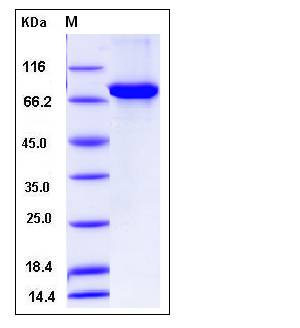Human ALDH4A1 Protein (His & GST Tag)
ALDH4,P5CD,P5CDh
- 100ug (NPP1885) Please inquiry
| Catalog Number | P12856-H20B |
|---|---|
| Organism Species | Human |
| Host | Baculovirus-Insect Cells |
| Synonyms | ALDH4,P5CD,P5CDh |
| Molecular Weight | The recombinant human ALDH4A1/GST chimera consists of 776 amino acids and has a calculated molecular mass of 86.8 KDa. It migrates as an approximately 75 KDa band in SDS-PAGE under reducing conditions. |
| predicted N | Met |
| SDS-PAGE |  |
| Purity | > 96 % as determined by SDS-PAGE |
| Protein Construction | A DNA sequence encoding the mature form of human ALDH4A1 (AAH07581.1) (Lys 25-Gln 563) was fused with the N-terminal polyhistidine-tagged GST tag at the N-terminus. |
| Bio-activity | |
| Research Area | Developmental Biology |Metabolism |Pathways and Processes |Metabolic signaling pathways |Amino acid metabolism |
| Formulation | Lyophilized from sterile 20mM Tris, 500mM NaCl, pH 8.5, 10% glycerol 1. Normally 5 % - 8 % trehalose and mannitol are added as protectants before lyophilization. Specific concentrations are included in the hardcopy of COA. |
| Background | ALDH4A1 is a member of the aldehyde dehydrogenase family. Aldehyde dehydrogenase enzymes function in the metabolism of many molecules including certain fats (cholesterol and other fatty acids) and protein building blocks (amino acids). Additional aldehyde dehydrogenase enzymes detoxify external substances, such as alcohol and pollutants, and internal substances, such as toxins that are formed within cells. ALDH4A1 is expressed abundantly in liver followed by skeletal muscle, kidney, heart, brain, placenta, lung and pancreas. It is a mitochondrial matrix NAD-dependent dehydrogenase which catalyzes the second step of the proline degradation pathway, converting pyrroline-5-carboxylate to glutamate. Defects in ALDH4A1 are the cause of hyperprolinemia type 2 (HP-2). HP-2 is characterized by the accumulation of delta-1-pyrroline-5-carboxylate (P5C) and proline. The disorder may be causally related to neurologic manifestations, including seizures and mental retardation. |
| Reference |
